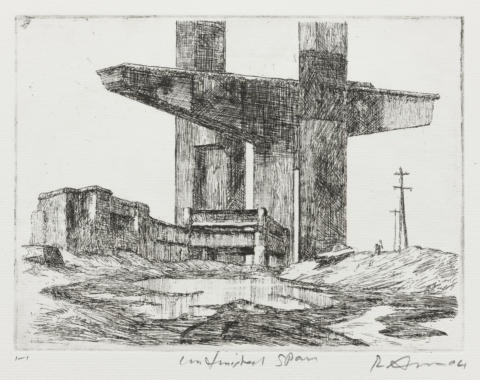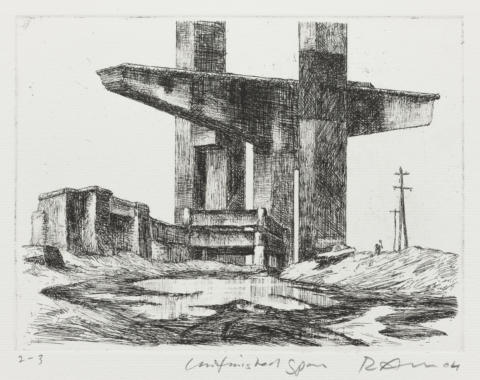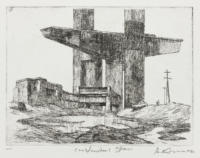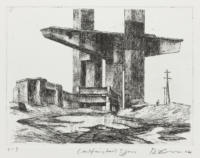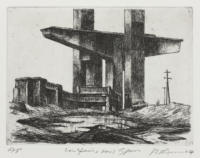
Etching. The giant T-shaped concrete support of an unfinished bridge dominates a view set in a wasteland of excavated earth, with pools of standing water in the foreground and three telegraph poles in the right distance. At the right of the structure is a raised earthen ridge on which stands a car, while a figure walks uphill away from it. The composition is resolved in all its essential details.
More cross-hatching has been applied to the concrete structures so as to balance the light tones burnished into them in the previous state. There are three variant impressions of this state.
The contours of the low concrete structures have been strengthened and clarified, and loose etched shading has been added to the ridge of earth on the right. Horizontal etched lines have been added to the reflections in the pool of water, and more loosely etched lines have been applied to the mound of soil at the lower centre. There are five variant impressions of this state.
- Catalogue Number
- E.132
- Title and Date
- Unfinished span 2004
- Description of Featured Image
- The giant T-shaped concrete support of an unfinished bridge dominates a view set in a wasteland of excavated earth, with pools of standing water in the foreground and three telegraph poles in the distance at right. At the right of the structure is a raised earthen ridge on which stands a car, while a figure walks uphill away from it.
- Where Made
- Alphington, Melbourne
- Medium Category and Technique
- Intaglio Print: Etching, burnishing and drypoint on copper
- Support
- Wove paper. Identified papers: Magnani paper with watermark: Romanesque ‘M’ with cross above; Velin Arches paper.
- Dimensions
-
Image size: 150 x 200 mm
Matrix size: 150 x 200 mm - Artist’s Record Number
- RAE.157
- Printer(s) and Workshop(s)
- All state impressions printed by Rick Amor in his Alphington studio. Edition printed by Rosalind Atkins at the Australian Print Workshop, Fitzroy (Melbourne).
- Summary Edition Information
- Six states. Edition of ten numbered impressions, 2005; edition impressions dated 2004 (this being the year in which all states were completed).
- Exhibitions
- University of Queensland 2014: University of Queensland Art Museum, St Lucia (Brisbane), Five Centuries of Melancholia, 30 August – 30 November 2014, ed. 3/10.
- Literature
- For an illustration of the painting Unfinished span, 2003, see Niagara Galleries, Rick Amor (exh. cat.), Niagara Galleries, Richmond, Victoria, 2004, cat. no. 1.
- For an illustration of the painting made after the etching, see Gavin Fry, Rick Amor, Beagle Press, Roseville, NSW, 2008, p. 168.
- Andrea Bubenik, Five Centuries of Melancholia (exh. cat.), University of Queensland Art Museum, Brisbane, 2014, p. 117.
- Collections
- State Library of Victoria, Melbourne: nine state impressions, numbered 1-1 through 1-5, 2-3, 3-3, 2-5, 3-5, all dated 2004; bon à tirer impression, dated 2004; AP, AP 2/2, both dated 2004.
- British Museum, London: ed. 1/10, dated 2004 (2006,0730.35).
- National Gallery of Australia, Canberra: ed. 3/10, dated 2004 (2007.745).
- Comment
E.132 is closely based on a painting of the same title, made in 2003 (Niagara Galleries 2004), the main differences between print and painting being the inclusion of one figure (instead of two) in the etching, and the figure’s placement to the left (instead of the right) of the telegraph poles. Another painted version of the subject followed the etching, in 2005–06 (Fry 2008).
The scene depicted in E.132 is – typically for Amor – a combination of motifs from several landscapes: Melbourne’s Bolte Bridge, when under construction (1996–99); Lorimer Street, Port Melbourne; and, at the centre left, the remains of the Gas and Fuel Buildings, which formerly stood on the site where Federation Square now stands, in central Melbourne. An oil plein-air sketch by Amor of the Bolte Bridge at an earlier stage of construction is in the State Library of Victoria (H2009.82/14); this work shows the cantilever construction from the same angle as in the etching, but depicted in its true, watery setting.
Amor’s concern as he worked through the six states of E.132 was to calibrate the print’s light and dark tones while also clarifying the contours of the span structure in order to give it a sense of massive weight and presence. Beneath it the tiny human figure appears shrunk and struggling. Andrea Bubenik has described the unfinished or abandoned bridge span as symbolic of frustrated human actions and as thus being a fitting metaphor for melancholia (Bubenik 2014).
- Keywords
- Bolte Bridge, Melbourne, Bridge
- URL
- https://catalogue.rickamor.com.au/works/intaglio/unfinished-span/
Record last updated 16/02/2021
